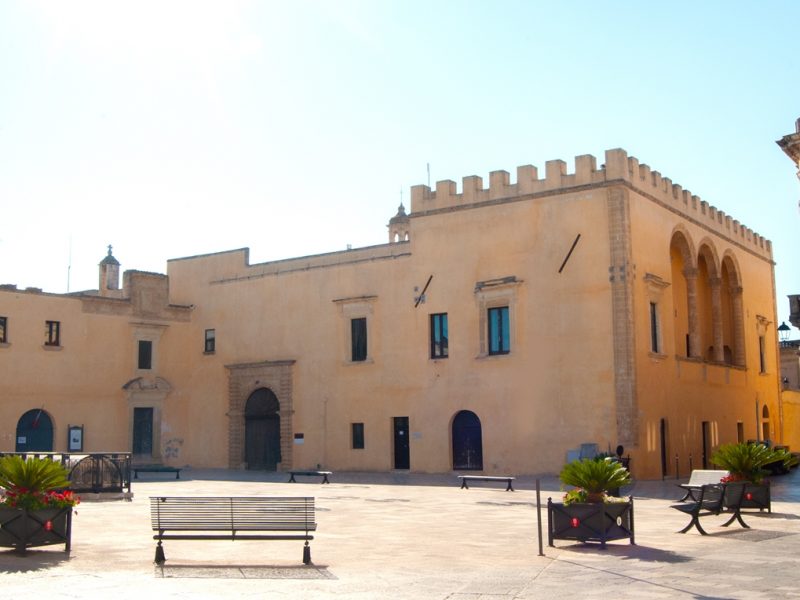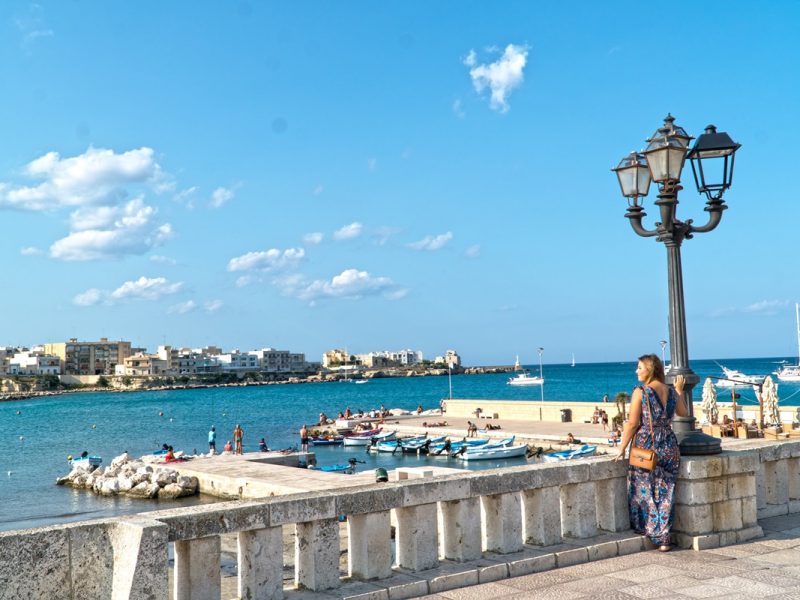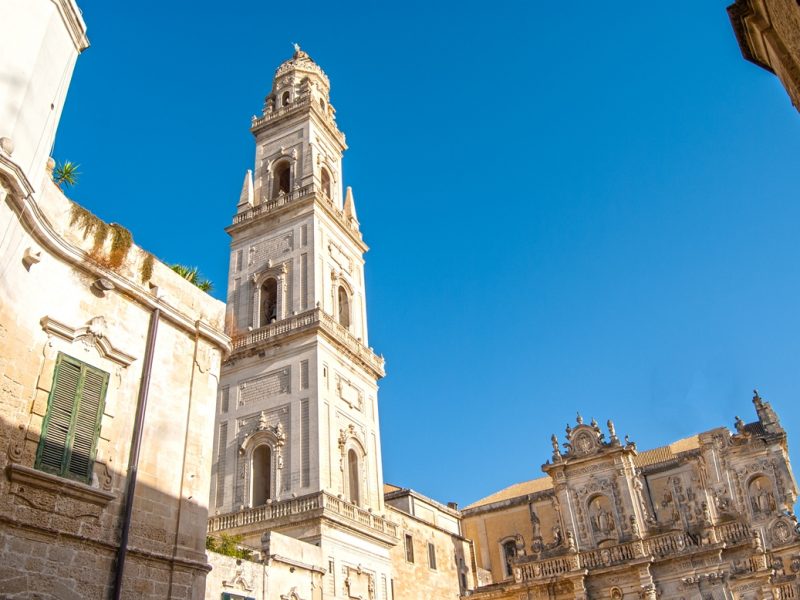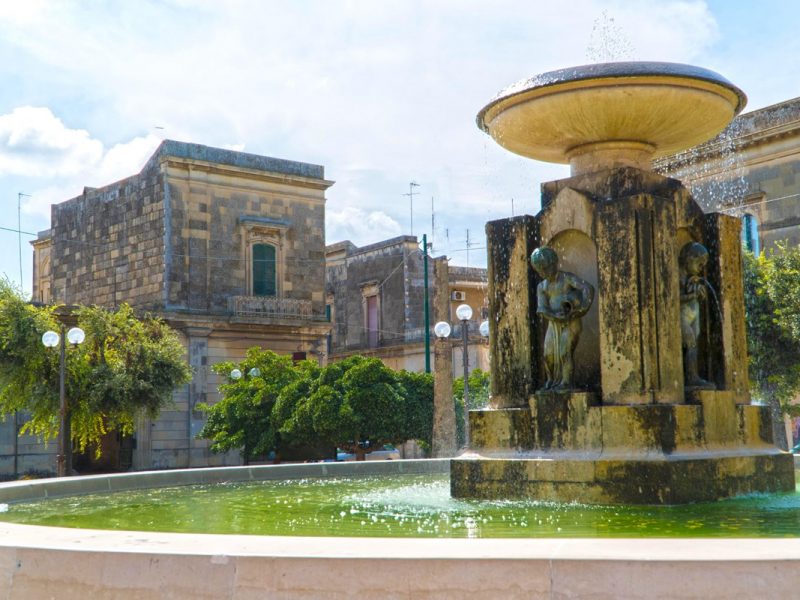The Borgo of Taviano
Taviano is the Sanremo of Salento, in fact, it is called: “The City of Flowers”.
The recent restoration of the historical center has infused the city with a dynamic and youthful spirit, with clubs and restaurants animating the evenings, and ancient lanes inviting one to explore interesting new angles of the little town. Architecturally, the key word to describe Taviano is sobriety. The ancient houses built around courtyards, the “casa a corte”, and the subterranean olive mills, the “frantoi ipogei”, give testimony to the simple lives of the farmers, and the numerous churches include Baroque features while maintaining facades of refined elegance.
Taviano also has the privilege of being refreshed by the breeze from its marina, Mancaversa, a short distance from the town. The crystal clear sea with bays and jetties makes it an irresistible destination for visitors in the summer months. After a rejuvenating swim and walk around the historical center, no one can resist the charm of this little town, and whoever leaves Taviano leaves a piece of their heart.
History
Recounting the history of Taviano is a bit of an obstacle course, a slalom through time, between fragments of information, hearsay, and staggeringly little historical documentation. From the “Specchie” (accumulation of stones on high ground) and the “Menhir” (enormous stone monuments), we know that the territory has been inhabited since the Neolithic period, but there is controversy on the actual founding of the city, which most attribute to the era of the Roman Empire.
In the Middle Ages, the feudal fief of Taviano was under the rule of various feudal lords, among them, Raimondello Orsini Del Balzo, but the most important family was the De Franchis line, with the Palace of the Marquis still bearing their name.
In the 1800’s, Taviano was in critical condition, due to the stagnant marshes that surrounded the town and mismanagement of the public administration. With the lack of basic hygienic conditions, dilapidated housing, rotten meat sold in the public squares, open sewers, rats scurrying freely through the streets, and delinquents wandering about unpunished, Taviano became prone to epidemics. This went on until the community, in desperation, rose up in protest against the administration, who, after claiming that no one was capable of fixing the situation, made a hasty escape. Debilitated, the long-suffering population gave a vow of loyalty to the Madonna, praying for her grace and protection… and… the nightmare ended. In Taviano, they still speak of this miracle today. Whether or not it is true, what matters is that modern day Taviano is a cheerful little town near the sea, with a rich offering of history, culture, and most of all, flowers.
Chiesa di San Martino, The Church of St. Martin
Salento is the land of secular olive groves but also of vast vineyards, and there is not a Salentino alive who would give up celebrating the “Novello”(new) wine on the saint’s day of San Martino, the 11th of November: commitments are interrupted, phones start ringing off the hook, it’s time to organize the celebration and come together to raise glasses full of “Novello” for a toast!
In Taviano, the 11th of November is a double holiday, because it San Martino is the city’s patron saint, to whom the main church is dedicated. The lines of the church are sober and austere, with a sloping roof and two niches for the statues of St. Peter and St. Paul. The interior is decorated in a subtle baroque style, without the typical opulence that confuses the eye. The paintings conserved in this church are of notable artistic interest and a recent addition is particularly marvelous: a series of paintings recounting the life of San Marino, created by the Tavianese painter Francesco Palma.
Santuario della Madonna del Miracolo, Sanctuary of the Madonna of the Miracle
The community of Taviano is animated by an ancient devotion to the Madonna of Taviano, who, at the end of the 1800’s, twice saved the citizens from epidemics of the Plague and meningitis. Her worship has continued over the centuries, keeping the devotion to the Madonna alive in the hearts of her followers. As a sign of gratitude to the Virgin Mary, the population sacrificed their most precious possessions to donate the gold needed to forge her golden crown. Other objects of value were donated later, and even today new brides bring bouquets of white flowers in her homage.
The statue of the Madonna del Miracolo, or the Madonna Addolorata (the Suffering Madonna) is located in what was previously the Convento dei Frati Minore (the monastery of lower order priests), which was transformed in 1952 to the present Sanctuary of the Madonna of the Miracle.
The façade and the interior are in full Baroque style, the wooden altars are artfully carved and the organ is of notable interest for art aficionados.
The Sanctuary remains open at the disposition of the faithful who come to pay homage to the Madonna or to offer bouquets of white flowers in honor of special occasions, a sign of the unbreakable bond between Taviano and the Virgin Mary.
Palazzo Marchesale, the Palace of the Marquis
The crown jewel of the city, the Palace of the Marquis is situated in the most ancient part of the historical centre of Taviano. The date of its construction is unknown, and though it has hosted various noble families, today it still bears the name Palazzo De Franchis, the last feudal ruler.
Taviano has always understood and profited from the value of this magnificent palace, and over the years has continued to protect and enhance its beauty with restoration projects in order to keep it open to the public. For several years now, it has hosted exhibitions and events of national importance, and has also become home to a municipal art gallery, another advantage for Taviano, realized thanks to the generous donation of important works made by a private collector.
The palace faces the Piazza del Popolo (the Peoples’ Square) and the exterior is plain and unadorned. The interior, however, is richly decorated, both in the noble residence on the first floor as well as on the ground floor, where arched-ceilings give the rooms a rustic, ancient feeling.
Palazzo
Marchesale, the Palace of the Marquis
The crown
jewel of the city, the Palace of the Marquis is situated in the most ancient
part of the historical centre of Taviano. The date of its construction is
unknown, and though it has hosted various noble families, today it still bears
the name Palazzo De Franchis, the last feudal ruler.
Taviano has
always understood and profited from the value of this magnificent palace, and
over the years has continued to protect and enhance its beauty with restoration
projects in order to keep it open to the public. For several years now, it has
hosted exhibitions and events of national importance, and has also become home
to a municipal art gallery, another advantage for Taviano, realized thanks to
the generous donation of important works made by a private collector.
The palace
faces the Piazza del Popolo (the Peoples’ Square) and the exterior is plain and
unadorned. The interior, however, is richly decorated, both in the noble
residence on the first floor as well as on the ground floor, where
arched-ceilings give the rooms a rustic, ancient feeling.
The Name of the Town
Even today, the origins of Taviano remain open for discussion, as to whether it was founded by the Romans, and if so, by the Empire, or by the First Republic. Or perhaps it was a Greek colony? In any case, a legend recounts that, during the expansion of the Roman Empire, the Emperor Octavian himself passed through the little town. He reigned in his horse and asked a passerby the name of the place he was travelling through. The man answered sincerely that no one had ever given it a name. Stunned, Octavian decided to give his own name to the village, and so, for a long time it was called Octaviano.
“A San Martino ogni mosta divinta vino”
At the Festival of St Martin, every grape becomes wine
Sooner or later, a Salentino away from home gets a disappointing surprise: once away from the “Tacco d’Italia (the heel of the boot in Italy), San Martino is not celebrated. In Salento, however, the day is sacred, full of rituals related to the fermentation of the grapes, the day when a merchant from far away came and gave his cloak to a poor beggar shivering with cold. Sacred or profane as it may be, on the eleventh of November, a true Salentino will never renounce a toast with novella wine. And while throughout territory it is an untouchable tradition, in Taviano it is almost a moral obligation, the echo of glasses clinking together fills the squares and the streets..filling the air with the scent of freshly picked, crushed grapes.
San Martino, the patron saint of the town, has always seemed like a personal friend to the population of Taviano. The elders still talk about the time when the statue was being carried in the procession and a man slipped a sardine into the mouth of the saint, to remind him of thirst, and to pray for grace in the time of drought, an alternative to the traditional rain dance.
San Martino represents that dusky gem born from the dry earth, the sacred grape, celebrated with banquets, novella wine, and animal fairs with horned animals, still celebrated in Taviano on the 12th of November with Santu Martinieddhu, which close the festivities, and also close the agricultural year, to then initiate a new one, in close correspondence with the ancient pagan New Year of Semain.
Do you know famous people of this borgo? Contact us!
Do you know typical recipes of this borgo? Contact us!

 Italiano
Italiano
 Deutsch
Deutsch


















